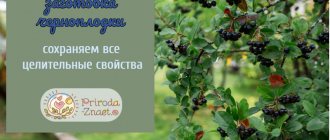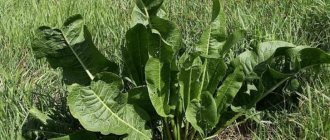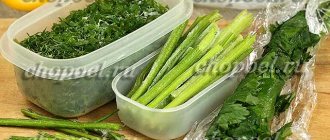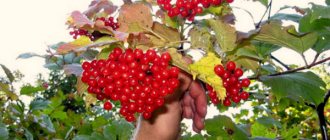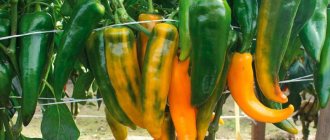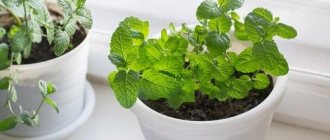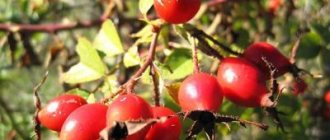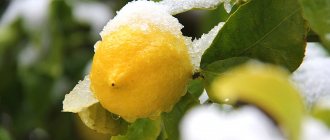Rowan - berries collected in clusters and creating the impression that the tree is lavishly decorated for the winter. Bullfinches and other birds enjoy eating them. For many, red rowan is what slightly dilutes the severity of the winter landscape. There is a popular belief that if there are a lot of fruits on a tree, then the winter will be harsh. However, this is not the only thing that connects rowan berries with winter. They are a storehouse of vitamins and useful microelements, so by stocking up on rowan berries for the winter, you can successfully survive the cold season, almost without getting sick or quickly overcoming ailments.
There are several options for harvesting fruits. Rowan can be frozen, dried, or made into jam. However, in a cool, not damp place, the berries can be successfully stored fresh for more than one month.
Red rowan - Marina Tsvetaeva’s favorite
“The Rowan tree lit up with a red brush. The leaves fell, I was born.” Remember the lines from the famous poem?
Rowan is mentioned in many poems of the great poetess. It was with this tree and its bright fruits that she associated her birth, associated her life and creativity.
Rowan in Tsvetaeva’s poems is an image of a bright and beautiful creative life, burning with the fire of lyricism, as well as an image of Russia.
And it’s time for us to fall in love with this Russian autumn beauty berry, because it is incredibly healthy! It was not for nothing that Marina Tsvetaeva loved her so much.
To this day I
I want to gnaw
Roast rowan
Bitter brush.
M. Tsvetaeva
How to make rowan jam
Rowan jam is a storehouse of vitamins. And in winter, a jar of rowan jam is better than medicine. It is better to pick berries in October and November, when they are caught by the first frost. They will become less bitter. Rowan jam is very healthy, beautiful and tasty, so be sure to try making it if you have the opportunity to get rowan. By the way, you can add other berries to rowan jam - you get a mix.
- Recipe for rowan jam No. 1
Rowan - 1 kg Sugar - 2 kg Water - 2 cup
Separate rowan berries from the branches and wash. Pour water over the berries and simmer over low heat for 10 minutes. Drain the water and dry the berries. Boil syrup from sugar and water, add berries and cook for 20 minutes. Leave to infuse for 8 hours. Do 2 more boils for 10 minutes and leave for at least an hour. Drain the syrup for the last time and reduce it well. Place the berries in jars and fill with hot syrup. Roll up the jars.
Beneficial properties of red rowan and contraindications for use
Since ancient times, red rowan juice has been used to treat diseases of the digestive tract and metabolism, diabetes mellitus, gout, rheumatism and even tuberculosis, and a decoction of rowan bark was used for fatty liver.
Red rowan berry pulp was used to treat warts, purulent abscesses, eczema and acne. Decoctions and infusions of berries were used to cleanse the blood and lymph.
Today, red rowan (dried and fresh) is used in cases where:
- rapid strengthening of the immune system is required in case of a viral or other infection;
- you need an anti-inflammatory drug to complement drug therapy for tonsillitis, bronchitis, laryngitis, tracheitis, pharyngitis, otitis, and so on;
- it is necessary to strengthen the vascular walls;
- it is required to stimulate appetite and increase intestinal tone.
Beneficial properties of red rowan
- Rich in vitamin C, which helps strengthen the immune system and cope with seasonal diseases.
- Contains a lot of vitamin A and beta-carotene, which make the skin beautiful and healthy, and the hair strong and shiny. Helps fight age-related dryness and peeling, heal “jams” in the corners of the lips.
- Contains the full range of B vitamins that strengthen the nervous system.
- Vitamin P copes well with the manifestations of atherosclerosis and normalizes cholesterol levels in the blood.
- Due to the content of many amino acids and organic acids (ascorbic, folic, sorbic, etc.), it has pronounced anti-inflammatory, wound-healing, and rejuvenating properties.
- Sorbic acid has a bacteriostatic effect and actively fights pathogenic microorganisms, fungi, viruses and bacteria.
- It contains many useful microelements (potassium, calcium, sodium, magnesium), as well as iron, which is beneficial for our blood, so rowan is an effective remedy against anemia.
- Stimulates the gastrointestinal tract, having a mild laxative effect, thanks to pectin and sorbitol, so rowan helps fight constipation and helps with senile intestinal atony.
Contraindications to the use of red rowan
Contraindications to the consumption of red rowan fruits are:
- hypotension,
- thrombosis,
- hyperacidous gastritis,
- gastrointestinal ulcers,
- diarrhea,
- ischemia,
- heart attack,
- pregnancy and early childhood.
Beneficial properties of rowan
How is rowan useful, what medicinal properties of rowan can be used by people. So, the benefit of rowan lies in the unique composition of its berries. Rowan contains a whole complex of vitamins and minerals that the body needs. Ripe red rowan berries contain organic acids (malic, sorbic, citric, succinic, tartaric), tannins and pectin, amino acids, essential oils, a lot of potassium, magnesium, phosphorus, iron and other trace elements. Vitamin A, vitamin PP, vitamins B1, B2 and C, as well as vitamins P, K, E. There is more provitamin A in ripe rowan berries than in carrots, and vitamin C than in lemons. The presence of vitamin P puts rowan in one of the first places among other fruit plants - it strengthens the nervous system, eliminates irritability, insomnia and general weakness of the body.
The beneficial properties of rowan are useful in the treatment and prevention of atherosclerosis; rowan has a diuretic and hemostatic effect. The juice is used for hemorrhoids, gastritis with low acidity. Rowan phytoncides are destructive to Staphylococcus aureus, salmonella, and mold; sorbic acid, which has bactericidal properties, is isolated from rowan and is used in the preservation of juices and vegetables.
An important component of rowan berries is pectin , which prevents excessive fermentation of carbohydrates, which is manifested by suppression of gas formation in the intestines. The gelling properties of pectin help eliminate excess carbohydrates.
Parasorbic and sorbic acids in rowan , discovered more than 100 years ago, have only attracted the attention of researchers in recent decades. It turned out that they inhibit the growth of microorganisms, fungi and molds. For women, eating rowan will be a good prevention of such troubles as thrush and fungal diseases.
Rowan has choleretic properties, which are associated with the presence of sorbic acid and sorbitol . Sorbitol lowers fat in the liver and cholesterol in the blood. Powder and paste made from rowan fruits act similarly. The choleretic property of rowan berries is due to the participation of not only sorbitol, but also other substances (amygdalin, organic acids).
Amygdalin, contained in rowan berries, increases resistance to oxygen starvation. It is proposed as a drug with radio- and X-ray protective action. This property is associated with the use of rowan berries among people in case of intoxication - they are given to the patient to chew. Amygdalin is involved in protecting fats from peroxidation, as a result of which rowan is used in folk medicine for atherosclerosis.
Rowan is used as a therapeutic and prophylactic agent for conditions accompanied by vitamin deficiency. Juice from fresh rowan berries is recommended for low acidity of gastric juice - 1 teaspoon before meals.
Rowan berries are used to make preserves, jams, jelly, juice, syrups , which reduce the permeability and fragility of capillaries; have a beneficial effect on cholesterol metabolism; have anti-edematous (dehydratic), choleretic properties; the ability to restrain putrefactive and fermentative processes in the intestines; useful for goiter (Graves' disease); stimulate hematopoiesis. But we should not forget that the complex of organic and inorganic substances of rowan fruits to a certain extent increases blood clotting . If you are prone to bleeding, this is useful, but if you are prone to thrombosis, you should not get carried away with rowan.
How to preserve red rowan
The best storage methods for vitamin-rich fruits are freezing and drying; it is with them that the largest amount of vitamins remains in the berries, especially vitamin C, which is known to be destroyed when heated. Dried berries can be stored for up to 2 years, and frozen for up to 1 year.
However, even in compotes and jams, useful substances remain in rowan: micro- and macroelements, minerals and tannins, the astringent, diuretic and choleretic properties of the berry are preserved.
It is not for nothing that the traditional method of preparation is rowan berries in their own juice and rowan compote without sugar. Sugar is not required as the fruits themselves contain natural preservatives.
It is important to remember: to prevent the berries from becoming bitter, before cooking they need to be soaked for 8-12 hours in cold water, and only then rinsed and used.
Red and chokeberry, pureed with sugar, can be stored for up to 6 months in the refrigerator.
What to cook from rowan
Infusion of red rowan berries : pour 1 teaspoon of fruit with 1 glass of boiling water, leave until cool. Drink 0.5 cups 1-3 times a day as a valuable multivitamin for allergic and other skin diseases.
In folk medicine, juice from fresh red rowan berries is recommended for low acidity of gastric juice; take 1 teaspoon before meals. Also, fresh rowan juice is an effective remedy for hemorrhoids. You need to squeeze the juice out of the rowan fruits and drink 1/4 cup, 3 times a day, with water.
Rowan tincture . Take a glass jar and fill it more than half the volume with rowan fruits. Then fill the entire container to the top with vodka and seal it. Place in a dark, cool place for 10-14 days, the tincture should turn dark brown and acquire a specific forest smell. The tincture is strained and stored in a cool, dark place. Take it one tbsp. spoon diluted in water at least 3 times a day.
Rowan berry juice is also very healthy. To do this, take 40 g of berries, grind them in a mortar, pour a glass of boiling water and leave for 4 hours. Then shake the contents well and filter through three-layer gauze. Add more sugar to the filtered infusion to taste.
Red rowan syrup can be easily prepared at home. Another recipe is used: rowan berries are crushed in a mortar and poured with boiling water in a ratio of 1:2, left for 4 hours, filtered and diluted with sugar syrup.
Rowan berry pastille is very tasty . The slightly bitter taste gives the delicacy a piquant flavor. For every kilogram of ripe rowan berries you need to take 2 kg of granulated sugar. Boil rowan until soft, grind and mix with sugar. Place the mixture on a baking sheet lined with paper or foil and dry in the oven at low (up to 75°C) temperature. Cut the finished marshmallow into diamonds and cubes with a sharp knife, cover with a layer of powdered sugar and place in boxes or jars with tight-fitting lids.
Candied rowan berries are even tastier than . To prepare it, ripe bunches need to be disassembled into small branches, washed and dried. Prepare sugar syrup as for candied fruits. Pour boiling syrup over rowan berry clusters and let them cool. Then remove the berries, bring the syrup to a boil again and pour it over the rowan again. The procedure is repeated 5-6 times until the berries darken and are saturated with syrup. After this, they need to be dried and sprinkled generously with powdered sugar. Can be stored in plastic boxes or any glass container. Anyway, this delicacy doesn’t last long - it’s too tasty.
Chokeberry - a berry from another field
You may be surprised to learn that the chokeberry is not at all related to the red one. These are completely different plants.
Chokeberry, or chokeberry, is a shrub native to North America; it is cultivated everywhere in Russia and produces even higher yields in our country than in its homeland.
The beneficial properties of chokeberry are similar to those of red rowan, but unlike the latter, chokeberry has a pronounced hypotensive property, can gently lower blood pressure and is actively used in folk medicine as a treatment for hypertension.
You can find out more about the beneficial properties of chokeberry in the publication “On the benefits of chokeberry. Medicinal properties of chokeberry. How to harvest and who should not eat chokeberry.”
How to prepare vitamin tea with rowan?
Vitamin teas from rowan are divided into preventive and therapeutic. The latter should be taken only on the recommendation of a doctor; in general, prophylactic teas have no contraindications. The only limitation for low blood pressure is rowan, like rosehip, hawthorn in this case is used with caution. Vitamin tea consists of two or more components, which are mixed in different proportions, depending on the desired effect. The most affordable and beneficial for the body are rowan teas with the addition of rose hips, black currants and chokeberries.
Vitamin tea made from rowan and rosehip fruits. As a rule, rowan and rosehip fruits are mixed in equal quantities to prepare vitamin tea. Take half a tablespoon of crushed rowan fruits and the same amount of rose hips. Pour two cups of boiling water. Infuse in a sealed container (preferably in a thermos with a glass flask) for a day. After this time, you will get an excellent multivitamin tea, to which honey is added to taste. It is especially useful to make such tea during the period of forced seasonal vitamin deficiency - at the end of winter and spring.
Vitamin tea from rowan and black currant . Mix half a glass of rowan fruits with the same amount of black currant berries, pour in a liter of boiling water and leave for two hours. Strain and add to black tea or drink half a glass several times a day. If you add raspberry syrup or jam to this tea, you will get an excellent antipyretic.
You can prepare a vitamin supplement from rowan for any herbal tea or ordinary black tea . To do this, you need to take equal parts of fresh rowan and rosehip berries (half a glass each), mash with a masher and pour two glasses of boiling water. Leave for two hours, strain and add the juice of one lemon. Vitamin tea can be diluted with boiling water or mixed with any hot tea.
How to cook red rowan
Sauerkraut with red rowan
Everyone knows that cabbage is fermented with cranberries. But it turns out that red rowan is also great for pickling.
It is enough to add a couple of handfuls of pre-washed and dried fresh berries to the cabbage when fermenting, and in a couple of days you will have delicious crispy cabbage with a new, slightly tart taste and a special autumn aroma on your table!
Soaked apples with red rowan
Place the prepared apples along with red rowan berries and raspberry leaves in sterile jars, pour in hot marinade (for 1 cup of boiling water, 1 tablespoon of sugar and 0.5 teaspoon of salt).
Cover the jars with parchment paper and leave for 10 days to ferment at room temperature. Then refrigerate for 20 days for further fermentation.
So, ferment and soak the red rowan - it will be very tasty!
Be healthy and see you again!
How to preserve the suitability of unprocessed rowan at home
The optimal place to store red or chokeberry fresh is a cellar, basement or refrigerator.
In a cellar or basement
Having collected a medicinal harvest, it must be carefully sorted, removing all leaves, twigs, insects, spoiled and crumpled specimens. You cannot wash the berries before storing them, otherwise their natural protective cover will be damaged.
Then, the rowan bunches must be strung on twine, so that they do not touch each other, and hung from a dry ceiling.
Another harvest of fresh rowan berries can be placed in balls in boxes made of cardboard or wood, making a layer of paper between each one. Holes must be made in the container in order to create good ventilation.
Taking into account temperature indicators, rowan berries can be suitable for consumption:
- until spring at 0 °C;
- for 3-4 months at 7-10 °C;
- up to one month (black) and up to two months (red) at 10-15 °C.
It is very important to monitor the air humidity in the room, which should not exceed 70%.
See the video “Preparing red rowan berries Drying and freezing”:
See also: how to dry rowan.
In a refrigeration device
If there is no suitable room, rowan berries can be successfully stored in the refrigerator compartment. To do this, they should be picked from the brushes, sorted, dried and placed in a clean, dry form in a paper or plastic bag and sent to the compartment where vegetables and fruits are usually stored. In this condition, rowan will be suitable for consumption for 1 month.
You can extend this period using granulated sugar. You need to sprinkle the bottom of a plastic container with it, then lay out the rowan berries and thus alternate the ingredients to the very top.
You can preserve rowan berries by sprinkling them with sugar:
- in the area between the refrigerator compartment and freezer for up to six months;
- in the compartment where it is customary to keep fruits and vegetables for up to 3 months.
You can also extend the usefulness of the rowan harvest if it is ground with sugar (2:1). The resulting puree must be transferred to sterile dry jars, tightly closed with lids and placed on the middle shelf of the refrigerator. This dessert can be stored for no more than 1 year. It’s better to do this with chokeberry; it’s juicier and sweeter.
If there are other plans for rowan, but there is no time to implement them yet, then the non-wet bunches can be placed in a plastic or paper bag and the fruits can be placed in the refrigerator on the shelf for fruits and vegetables. They will be valid for 30 days.
In the freezer
The ideal way to preserve the beneficial qualities of fresh rowan is “shock” freezing (-18 °C and below). Under such conditions, the amount of carotene (it is found in red rowan) even increases. After sorting and washing the fruits, they should be laid out on a towel to dry at room temperature, and then placed in one ball on a tray and placed in the freezer. After 4 hours, the berries must be put into bags and stored in the freezer for a whole year.
Frozen puree can also be stored for 1 year (the proportion of berries and granulated sugar is 1:0.5).
How and when to collect rowan?
- In September, rowan berries are collected for fresh storage . At this time, the berries already acquire the color and size characteristic of the variety, but they are quite bitter because they are not frozen. But they are great for long-term storage. To preserve rowan, the bunches of berries are hung in a cool room. In September, rowan berries are collected using tassels.
- In November, after the first frost, rowan berries are harvested for harvesting . By this time, the bitterness has mostly gone away, and the berries acquire a pleasant sweetish taste. During this period of time, rowan is very easily separated from the stalks and becomes more juicy. It is difficult to keep such berries fresh - they quickly lose their juice and spoil, but you can make various preparations from frozen rowan. In November, only berries are harvested.
